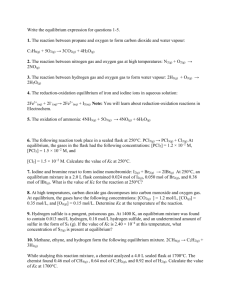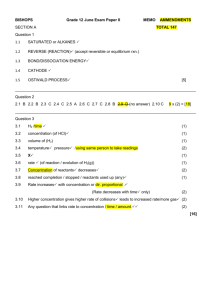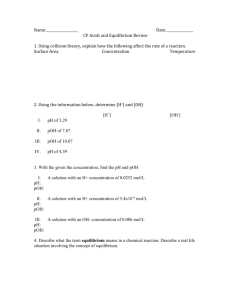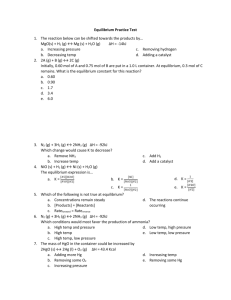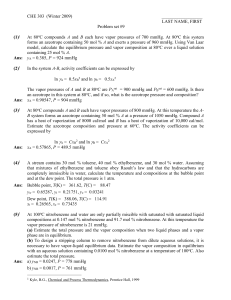CHEM GS Exam (ENGL Version)
advertisement
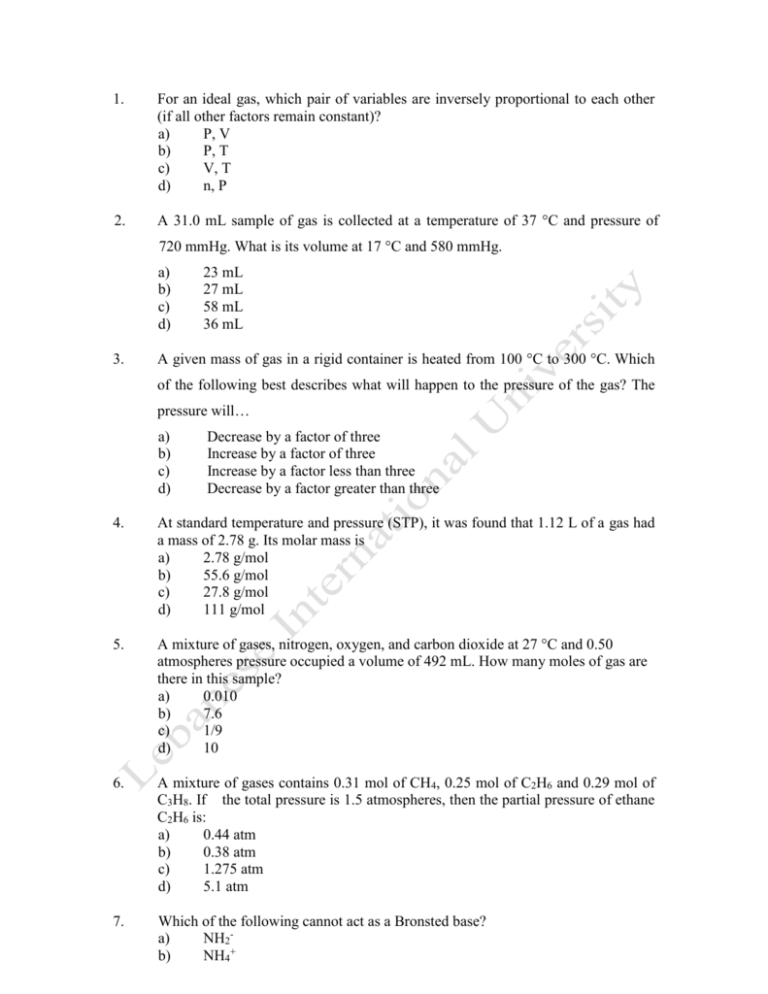
1. For an ideal gas, which pair of variables are inversely proportional to each other (if all other factors remain constant)? a) P, V b) P, T c) V, T d) n, P 2. A 31.0 mL sample of gas is collected at a temperature of 37 °C and pressure of 720 mmHg. What is its volume at 17 °C and 580 mmHg. a) b) c) d) 3. 23 mL 27 mL 58 mL 36 mL A given mass of gas in a rigid container is heated from 100 °C to 300 °C. Which of the following best describes what will happen to the pressure of the gas? The pressure will… a) b) c) d) Decrease by a factor of three Increase by a factor of three Increase by a factor less than three Decrease by a factor greater than three 4. At standard temperature and pressure (STP), it was found that 1.12 L of a gas had a mass of 2.78 g. Its molar mass is a) 2.78 g/mol b) 55.6 g/mol c) 27.8 g/mol d) 111 g/mol 5. A mixture of gases, nitrogen, oxygen, and carbon dioxide at 27 °C and 0.50 atmospheres pressure occupied a volume of 492 mL. How many moles of gas are there in this sample? a) 0.010 b) 7.6 c) 1/9 d) 10 6. A mixture of gases contains 0.31 mol of CH4, 0.25 mol of C2H6 and 0.29 mol of C3H8. If the total pressure is 1.5 atmospheres, then the partial pressure of ethane C2H6 is: a) 0.44 atm b) 0.38 atm c) 1.275 atm d) 5.1 atm 7. Which of the following cannot act as a Bronsted base? a) NH2b) NH4+ c) d) CO32NH3 8. The pOH of a solution of NaOH is 11.30. What is the [H3O+] for this solution? a) 2.0 x 10-3 b) 2.5 x 10-3 c) 5.0 x 10-12 d) 4.0 x 10-12 9. Which of the following produces the strongest conjugate base? a) HClO (pKa = 7.53) b) HCOOH (pKa = 3.75) c) CH3COOH (pKa = 4.75) d) HIO (pKa = 10.64) 10. Calculate the [OH-] (in M) for an acetic acid solution (Ka = 1.8 x 10-5) having a pH of 4.36. a) 4.20 x 10-10 M b) 4.60 x 10-10 M c) 2.30 x 10-10M d) 4.37 x 10-5 M 11. A strong acid in solution is ___________. a) Mostly molecules b) Mostly ions c) Both molecules and ions d) Mostly water 12. A salt derived from a strong base and a weak acid will give a salt that is _______. a) Acidic b) Basic c) Neutral d) Volatil 13. A weak base in solution is ___________. a) Mostly molecules b) Mostly ions c) Both molecules and ions d) Mostly water 14. Which of the following statements is true concerning acids and bases? a) Acids and bases don't react with each other b) Acids mixed with bases neutralize each other c) Acids mixed with bases make stronger bases d) Acids mixed with bases make stronger acids 15. An amphoteric substance can act as ___________ a) Both an acid and a base b) Acid c) Base d) No Acid Neither Base 16. During the titartion of Strong Acid with a Strong Base the equivalence point is achieved at a pH : a) Less than 7 b) Great than7 c) 14 d) 7 17. Which of the following represents the curve of weak acid strong base : a) b) c) d) 18. In the titration of a weak acid of unknown concentration with a standard solution of a strong base, a pH meter was used to follow the progress of the titration. Which of the following is true for this experiment? a) The pH at the equivalence point depends on the indicator used b) The graph of pH versus volume of base added rises gradually at first and then much more rapidly c) The graph of pH versus volume of base added shows no sharp rise d) The [H+] at the equivalence point equals the ionization constant of the acid 19. For the hypothetical reaction A + 3B 2C, the rate should be expressed as: Δ[A] _________ a) Rate = Δt Δ[C] b) Rate = ─ _________ Δt 3 Δ[B] c) Rate = ─ ____________ Δt Δ[C] d) Rate = __________ 2 Δt 20. Which of the following are the correct units for the rate constant, k, for a zero-order reaction? a) Mole. l-1. s-1 b) Mole. l-2. s-1 c) Mole. L. s-1 d) Mole. l-1 21. The time required for 100% completion of a zero order reaction is a) b) c) d) ak 22. The rate constant of a first order reaction depends on the a) b) c) d) 23. Temperature Time Concentration of the reactant Concentration of the product A catalyst is a substance which a) Increases the equilibrium concentration of the product b) Increases the equilibrium constant of the reaction. c) Supplies energy to the reaction d) Shortens the time to reach equilibrium 24. In the reaction BrO3– (aq) + 5Br– (aq) + 6H+ → 3Br2 (l) + 3H2O(l) The rate of appearance of bromine (Br2) is related to the rate of disappearance of bromide ions as a) b) c) d) 25. Which is the correct equilibrium constant expression for the following reaction? Fe2O3(s) + 3H2(g) 2Fe(s) + 3H2O(g) a) b) c) d) e) Kc = [Fe2O3] [H2]3 / [Fe]2[H2O]3 Kc = [H2] / [H2O] Kc = [H2O]3 / [H2]3 Kc = [Fe]2[H2O]3 / [Fe2O3] [H2]3 Kc = [Fe] [H2O] / [Fe2O3] [H2] 26. On analysis, an equilibrium mixture for the reaction 2H2S(g) 2H2(g) + S2(g) was found to contain 1.0 mol H2S, 4.0 mol H2, and 0.80 mol S2 in a 4.0 L vessel. Calculate the equilibrium constant, Kc, for this reaction. a) 1.6 b) 3.2 c) 12.8 d) 0.64 27. Calculate Kp for the reaction 2NOCl(g) this reaction is 2.1 102. a) b) c) d) 2.1 102 1.7 103 0.70 1.2 2NO(g) + Cl2(g) at 400C if Kc at 400C for 28. In a 10L container, the composition of the mixture at equilibrium at 80 oC is 0.3 mole PCl5 and0.7 mol PCl3 and 0.7 mol Cl2. PCl5 ↔ PCl3 + Cl2 The equilibrium constants Kc and Kp are: a) Kc= 0.525 and Kp= 8 b) Kc= 0.163 and Kp= 4.718 c) Kc= 0.724 and Kp= 2.11 d) Kc= 0.884 and Kp= 3.21 29. For the reaction H2(g) + I2(g) 2HI(g), Kc = 50.2 at 445ºC. If [H2] = [I2] = [HI] = 3 1.75 10 M at 445ºC, which one of the following statements is true? a) The system is at equilibrium, thus no concentration changes will occur. b) The concentrations of HI and I2 will increase as the system approaches equilibrium. c) The concentration of HI will increase as the system approaches equilibrium. d) The concentrations of H2 and HI will fall as the system moves toward equilibrium. 30. At 700 K, the reaction 2SO2(g) + O2(g) 2SO3(g) has the equilibrium constant Kc = 6 4.3 10 , and the following concentrations are present: [SO2] = 0.10 M; [SO3] = 10. M; [O2] = 0.10 M. Is the mixture at equilibrium? If not at equilibrium, in which direction (as the equation is written), left to right or right to left, will the reaction proceed to reach equilibrium? a) b) c) d) Yes, the mixture is at equilibrium. No, left to right No, right to left There is not enough information to be able to predict the direction. Useful Information STP = 0°C = 273 K and 1 atm = 760 torr = 760 mmHg Ideal Gas Constant, R = 101.3 kPa L·mmHg = 62.4 mol·K L·atm = = 0.0821 mol·K L·kPa = 8.31 mol·K
